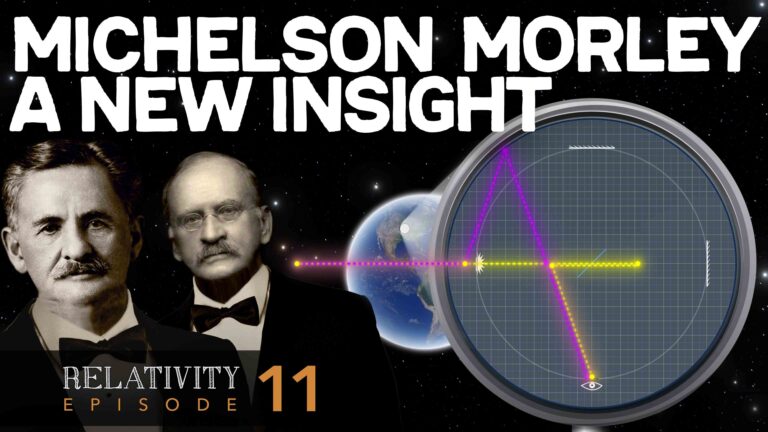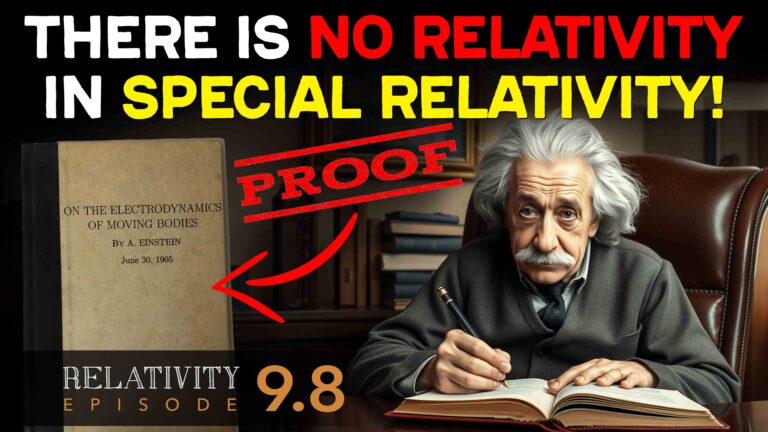Welcome to Ask Us Whatever. I’m Joe Sorge.
In Episodes 7.2 and 7.3 we talked about Einstein’s method of clock synchronization, and how it creates a spatial gradient of clock readings in moving inertial reference frames—what we’ve called a clock offset— linearly proportional to the distance separating the clocks.
In Episode 7.3, I emphasized that Einstein’s constant light speed postulate relies on this method of creating a difference between the readings on the distant clocks.
If two distant clocks report exactly the same time reading (the method used to synchronize the atomic clocks of the UTC clock network on the Earth), then light speed would not be constant.
Instead, light speed would be different in different directions: c – v in the direction of reference frame motion and c + v in the direction opposite to the direction of reference frame motion. So, in order to cause the measurement of light speed to be the same constant speed c in all reference frames, Einstein created a clock coordination method, described in Section 1 of his 1905 relativity paper, to adjust the clocks so that light speed measurements would produce the same result in all inertial reference frames.
It was like creating a graduated income tax system for clocks!
Now, certain critics of Special Relativity, including myself, have pointed out that Einstein’s clock synchronization method is self-serving. But Einstein was both incredibly intuitive and incredibly lucky. And it turns out that if two identical clocks are slowly moved apart, their time readings will naturally drift apart (and here’s the lucky part) by almost exactly the same amount of time that would be achieved with Einstein’s manual calibration protocol. Seem surprising? Let’s test it mathematically.
Picture two clocks, B’ and A’, moving through space at speeds u and v, respectively, in reference to a chosen stationary system of coordinates associated with frame S. According to special relativity, each clock’s tempo will be slowed by the Lorentz gamma factor computed at: either speed u for clock B’ or speed v for clock A’.
\(\gamma_L\left(u\right)=\frac{1}{\sqrt{\left(1-u^2/c^2\right)}} \)
\(\gamma_L(v)=\frac{1}{\sqrt{1-\frac{v^2}{c^2}}} \)
Picture clocks A’ and B’ both traveling in the positive x-direction. Picture clock B’ approaching clock A’ from behind such that speed u is slightly faster than speed v.
Let’s call speed u: v + dv, where dv is tiny compared to v.
\(u=v+dv \)
When clock B’ reaches the same x-position as clock A’, let’s assume for simplicity that their clocks report the exact same reading.
Clock B'‘s tempo for any given time interval dt will be equal to dt divided by the Lorentz gamma factor, evaluated at speed v + dv.
Effect of speed \(v+dv \) on clock \(B^\prime \) tempo = \(\frac{dt}{\gamma_L\left(v+dv\right)} \)
However clock A’ will beat slightly faster, such that a frame S time interval dt will appear on clock A’ to advance by dt divided by the Lorentz gamma factor evaluated at speed v.
Effect of speed \(v \) on clock \(A^\prime \) tempo = \(\frac{dt}{\gamma_L\left(v\right)}\)
After a given period of time, dt, the readings reported by clocks B’ and A’ will differ due to the slight difference in their clock rates. We call this difference the offset between the clocks.
\({dt^\prime}_{\text{offset}}=\frac{dt}{\gamma_L\left(v+dv\right)}-\frac{dt}{\gamma_L\left(v\right)}\ seconds^{\prime} \)
Now this is a difficult equation to solve exactly because of the square roots, but we can approximate it algebraically by expanding the square root terms using Taylor series expansion, which is reasonably valid to second order when v is small and dv is extremely small relative to speed c.
\({dt^\prime}_{\text{offset}}=dt(\sqrt{1-\frac{\left(v+dv\right)^2}{c^2}}\ -\sqrt{1-\frac{v^2}{c^2}}) \)
\({dt^\prime}_{\text{offset}}\approx dt(1-\frac{{(v+dv)}^2}{2c^2}-1+\frac{v^2}{{2c}^2}) \)
\({dt^\prime}_{\text{offset}}\approx dt\left(\frac{v^2-v^2-2vdv-dv^2}{2c^2}\right) \)
\({dt^\prime}_{\text{offset}}\approx dt\left(\frac{-2vdv-dv^2}{2c^2}\right) \)
This allows us to effectively ignore the dv-squared over 2 times c-squared term in the approximation. Therefore, the clock offset approximately equals negative dt times v times dv over c squared.
\({dt^\prime}_{\text{offset}}\approx-dt\left(\frac{vdv}{c^2}\right) \)
Now, again, provided that v is very small relative to c, for any given interval of time, dt, the distance that will separate clocks A’ and B’ in frame S’, will approximately be their difference in speed, dv, times the time interval dt.
\(dx^\prime\approx dv\times dt \)
This is not strictly correct on a unit-analysis basis, but when v is small relative to c, such that the Lorentz gamma factor is nearly equal to 1, it’s a close approximation. And so, the difference in readings between clocks A’ and B’ as observed from frame S will be approximately v times dx’ divided by c squared.
\({dt^\prime}_{\text{offset}}\approx-\left(\frac{vdx^\prime}{c^2}\right)\ seconds^{\prime} \)
The term on the right is the Frame S’ clock offset term of the Lorentz dt’ transformation, which is also the amount by which Einstein clock synchronization causes two clocks separated by distance dx’ to differ in their time readings.
\(dt^\prime=\frac{dt}{\gamma_L\left(v\right)}-\frac{vdx^\prime}{c^2}\ seconds^{\prime} \)
Stated another way, according to Special Relativity, if two clocks lie adjacent to each other within an inertial reference frame S’ moving slowly relative to a stationary system of coordinates, and one of the clocks is transported slowly away from the other clock, the time reading on the clock that was transported will lag behind the time reading on the clock that was not transported, and the amount of this time lag will be approximately equal to difference in time readings that would have been achieved if the separated clocks were alternatively synchronized using Einstein’s manual, light-signal synchronization method.
In other words, the normal process of separating clocks slowly (relative to light speed) may cause them to acquire a time-reading-offset, as a result of differential time dilation, that biases them such that if they are used to measure light speed, it will appear to make light speed constant in the frame of these clocks.
Now was that luck or was that genius? Let’s take a look at that.
Einstein stated in Section 4 of his 1905 relativity paper:
“If at the points A and B of K there are stationary clocks which, viewed in the stationary system, are synchronous; and if the clock at A is moved with the velocity v along the line AB to B, then on its arrival at B the two clocks no longer synchronize, but the clock moved from A to B lags behind the other which has remained at B by ½ t \(v^2/c^2 \) (up to magnitudes of fourth and higher order), t being the time occupied in the journey from A to B.”
So, Einstein knew that two distant clocks that he considered “synchronous” in a stationary inertial reference frame, would no longer be synchronous if one of the clocks was moved to join the other clock.
However, there’s a catch.
In his example, the reference frame K (or Frame S in our example) was stationary, which means that what we call the variable v (in other words the speed of the clocks’ reference frame through space) would be assigned a zero value in our formula for clock offset.
offset \(\approx t\left(\frac{-2v_{Frame\ K}\ {dv}_{Clock\ A}-{dv}_{Clock\ A}^2}{2c^2}\right)\approx-\frac{1}{2}t(\frac{{dv}_{Clock\ A}^2}{c^2}) \)
Einstein used the symbol “v” differently in the quoted paragraph to represent what we have labeled as “dv” in this expression. In either case, Einstein’s “v” and our “dv” represent the speed at which one of the clocks moves relative to the other clock.
Einstein’s statement therefore concerned the second order term, what we call \(dv^2 \) rather than the first order term \(2 \times v \times dv \) of our analysis.
That is, Einstein understood that clock readings in a stationary inertial reference frame would vary in proportion to the square of their relative speed within that reference frame, but he did not advance the differential speed analysis to the first-order term, which must be included if the reference frame of the clocks is moving through space. In other words, moving with respect to frame S.
Instead, he used the manual light-signal synchronization method, described in Section 1 of his 1905 paper, to quantify the offset between clocks that are moving through space. In other words, the offset of clocks in what he called frame K’. This may be because he realized that the slow transport method would be valid only if the clocks are moved extremely slowly, and therefore was not a generalizable concept. Or, it may have been because he simply failed to recognize the correlation between the slow transport of clocks, and the synchronization of clocks using a light signal. I’ve not found a report of this correlation until the year 1924, when Arthur Eddington published an analysis to show that the slow transport of clocks mimics Einstein’s clock synchronization.
So, in this case, Einstein was probably more lucky than visionary, in that his manual method for changing the readings on distant clocks mimics what might happen naturally if clocks are very slowly separated after having been set to the same reading when side by side.
As you probably know by now, I can’t resist poking the tiger when given the opportunity, so in the next episode I’m going show that this reasoning is all pretty defective, and instead anchor it to a universal preferred reference frame; and then I’m going to show how the physics community’s misunderstanding of these concepts led to what has been called the “twin paradox”, which really isn’t a paradox if you simply understand that clock rate is proportional to the movement of clocks with respect to the preferred reference frame rather than with respect to some arbitrary observer with a big ego.
OK, well that’s it for now. Please leave questions in the comments section. I’m Joe Sorge and thanks for watching.



